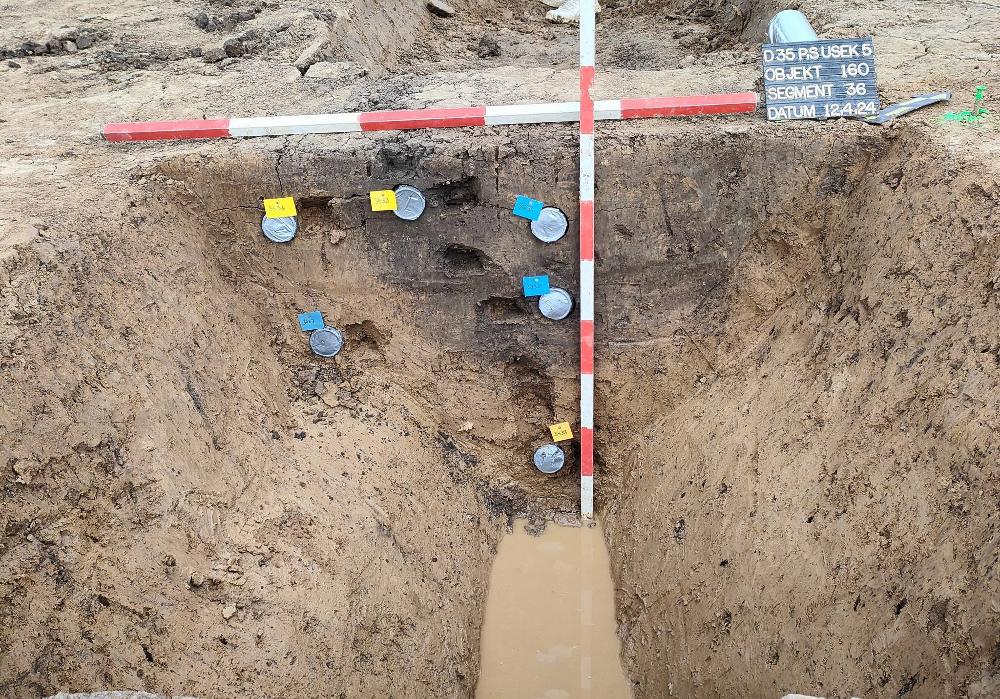Archaeologists Uncover 600-Foot Prehistoric Monument Amid Highway Dig
Archaeologists have made a rare and significant discovery, unearthing the remains of an enormous monument during excavations along the side of a highway route in the Czech Republic.
The team from the University of Hradec Králové has identified the structure as an ancient burial mound, a unique find that extends over 600 feet long. This discovery is expected to significantly enhance our understanding of the ancient inhabitants of the region.
Archaeologists Discover the Remains of An Ancient Burial Mound
During their dig near the villages of Dlouhé Dvory and Lípa in the eastern part of the Czech Republic’s Bohemia region, the archaeologists stumbled upon the remains of what appeared to be an ancient mound.

Source: Wikimedia
Upon further investigation, the researchers surmised it was a burial mound that could date back to around 4,000 BCE, making it one of the earliest and most significant structures of its kind in Europe.
The Size of the Burial Mound
During the excavation, researchers estimated that the structure was around 620 feet long and up to 50 feet across at its greatest width.

Source: Department of Archaeology UHK
On average, the structure, also known as a long barrow, is larger than similar burial mounds found throughout Europe. Some archaeologists suggest that it could be one of the longest ever unearthed on the continent, according to Newsweek.
The Significance of the Long Barrow
Petr Krištuf from UHK’s Department of Archeology at the Faculty of Arts shared a statement with the press highlighting the significance of the find.

Source: Wikimedia
“Mounds of this type are found mainly in northwestern Bohemia. They have not yet been reliably documented in Eastern Bohemia. In addition, the examined specimen represents the longest prehistoric mound not only in our region but probably in the whole of Europe,” he said, per The Science Times.
Archaeologists Discover Long Barrow Tomb Ahead of Construction Work
The archaeologists, engaged in precautionary excavation work prior to the construction of the D35 highway between Sadová and Plotiště, made the discovery of the long barrow tomb.

Source: Department of Archaeology UHK
During the excavation, the team managed to locate and excavate the entrance of the long barrow.
The Longest Barrow in Europe
Speaking on the history of long barrows and the most recent discovery in the Czech Republic, Ladislav Rytíř with the UHK Department of Archeology shared his thoughts.

Source: Wikimedia
“The long barrows are among the oldest and largest funerary monuments of European prehistory. And the barrow we’ve discovered is the longest long barrow yet excavated in Europe,” he said.
Monumental Funerary Objects
The UHK later shared a detailed account of their excavation on their Facebook page, explaining that burial mounds like the one previously discussed are generally built as monumental funerary objects.

Source: Department of Archaeology UHK
This suggests that researchers expected to find the remains of several ancient individuals within the long barrow, and they were not disappointed.
The Burials Contained Within the Long Barrow
According to historians, the long barrows were constructed as the final resting place for individuals of high status, who are referred to as “central” burials.

Source: Department of Archaeology UHK
In the case of this particular long barrow, two teams discovered two central burials. One of them features the skeletal remains of an Indian on its left side facing north. It was accompanied by a ceramic vessel thought to be a grave offering.
The Second Burial
The team also came across another centennial burial with another figure on its left side facing north.

Source: Department of Archaeology UHK
According to the UHK’s Facebook post, it was accompanied by “a collection of five objects of the stone chipped industry made of silicate glacigen sediments SGS, popularly known as the claw, is typically arrow tips and blades.”
Smaller Grave Inserted into the Mound
The archaeologists revealed they came across another grave within the mound, which produced some fragments of a human skull.

Source: Department of Archaeology UHK
“Another grave in the mound was inserted into the mound casing. It was a grave with an inner construction, with ball holes in the corners and troughs. Only skull fragments were very poorly preserved from human remains,” wrote UHK
27 Other Graves Discovered Within the Burial Mound
The UHK post details the discovery of several other graves within the long barrow.

Source: Wikimedia
“There are 27 other graves in addition to the burial mound, some of which also had an internal construction, which can generally be dated to the Eneolithic period, but the exact dating will only be possible after the findings have been analyzed in the laboratory,” they wrote.
The Significance of the Find
In a press release, Krištuf suggested that the find’s overall significance goes well beyond its enormous size.

Source: Department of Archaeology UHK
“The first results show that the monumental burial mound stood here for many centuries, and funeral and ritual activities of the local people took place in its vicinity. It was thus an important ritual place and landmark in the landscape at that time,” Krištuf said.
